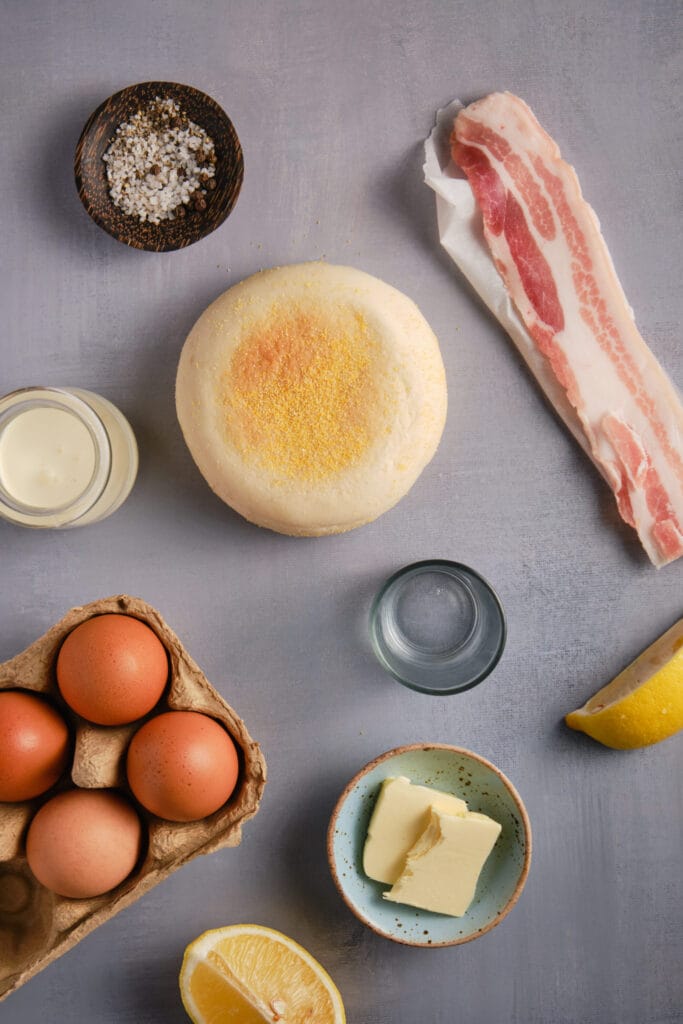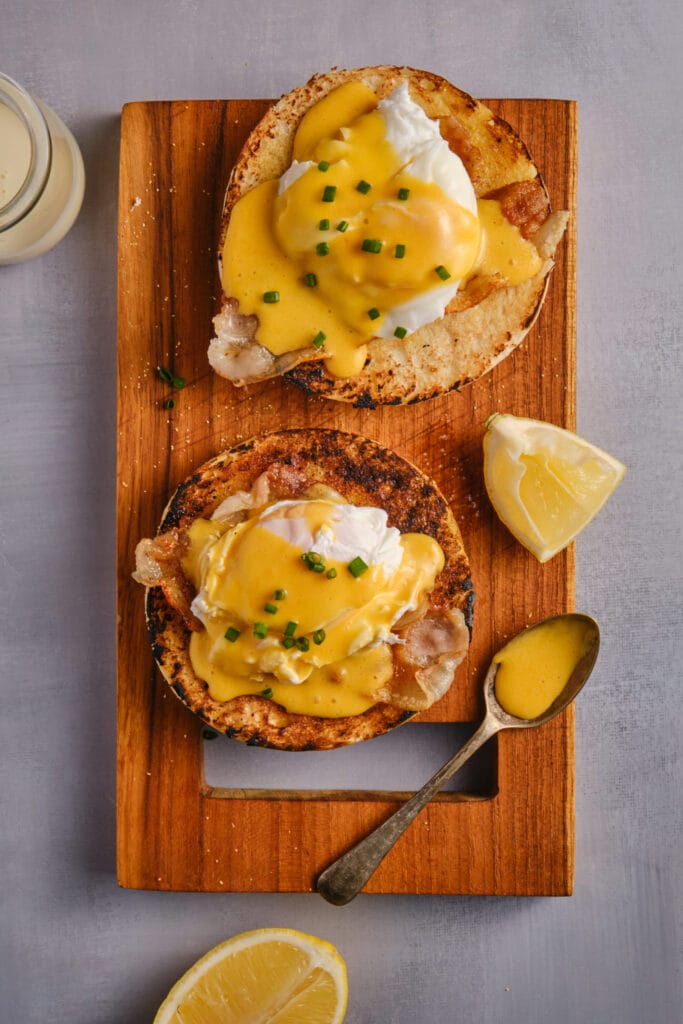[ad_1]
Fluffy eggs and tasty bacon set upon a crisp English muffin then drizzled with heavenly hollandaise sauce—now that’s our idea of Eggs Benedict.

Eggs benedict pulled a fast one on me!
When I was a student, my friends and I would take a break from late-night study sessions by hitting up the local diner. It was there that I discovered eggs Benedict. I fell in love with them so hard—especially that hollandaise sauce—I started skipping on studying and just went straight to the diner.
As expected, my grades suffered. My diet suffered (hollandaise sauce is rich!). My bank account suffered (I was not rich!). Very quickly I realized I had to make a few adjustments: i) I had to hit the books (eggs Benedict was a reward for studying, not a replacement for studying); ii) I had to learn how to make them myself. Unfortunately, back then, the only part I knew how to make was the English muffin—and even then I burnt it more times than I’d like to admit. Hollandaise sounded French; I couldn’t make French foods! At least, I didn’t think I could.
Of course, few things are as complicated as you make them out to be in your head. Such was the case with eggs Benedict. In no time I had mastered the art of their preparation (well, ‘mastered’ may be an exaggeration) and now, I pass on my wisdom to you. In the name of higher education and lower bank balances!
Is Eggs Benedict Healthy?
Eggs Benedict is a nice treat if enjoyed once in a while. The eggs and bacon do contribute to your daily intake of protein, though the latter also contains lots of sodium and fat. The butter used, while integral to the creaminess of the sauce, is also high in calories and fat. You can trim this recipe down and use whole wheat English muffins, lean ham instead of bacon, and cut down on the amount of butter—just don’t cut down so much it’s no longer a hollandaise sauce!
How Do I Thicken/Thin My Hollandaise Sauce?
The easiest, most direct way to thin out your hollandaise sauce is to add liquid. Whether that liquid be water, cream, or lemon juice is up to you and how much you want the increase to influence the overall taste of your sauce. My advice would be to add the liquid in small amounts and then whisk. You may also find you need to add more salt and pepper as the flavor may be diluted. To thicken your sauce, you should place the sauce over low heat and continue whisking until it’s reduced to your liking. Otherwise, you can add more egg yolk. Just be sure you continue whisking so you don’t end up with scrambled egg in your sauce.
INGREDIENTS
- 2 English muffins, split and toasted
- 4 large eggs
- 4 slices bacon
- splash of vinegar
- 4 tbsp unsalted butter
- 4 egg yolks
- 2 tsp lemon juice
- 1 tbsp heavy whipping cream
- salt and pepper to taste

INSTRUCTIONS
Toast
Toast the English muffins until golden. Set them aside.
Cook
Cook the bacon until warm and slightly browned, then layer on the muffins.
Poach
Poach the eggs in gently simmering water with vinegar until the whites are set.
Whisk
Whisk together egg yolks, lemon juice, and cream, then slowly add melted butter to make the hollandaise sauce.
Top
Top each egg with hollandaise sauce and serve hot.
Devour!

FAQs & Tips
I don’t recommend storing leftovers (as in, eggs benedict you’ve already assembled). The sauce could separate, the eggs could get overcooked when reheating, and the English muffin will no doubt be soggy. If the components are still separate, though, you can store a wrapped English muffin at room temperature for up to two days. The sauce can be stored in an airtight container for up to two days in the fridge. The bacon can be wrapped in plastic or aluminum foil and stored in the fridge for up to three days. And the egg can be kept in cold water in a container in the fridge for up to two days. To reheat, add the egg to hot water until warmed through.
The acid in the vinegar helps the egg solidify more quickly so it has less time to spread out in the water. It makes for a ‘tidier’ egg.
Whirling the water serves the same purpose as the vinegar: creating a compact egg. If you add the vinegar, you don’t really need to create the whirlpool.
Carefully crack open the egg but don’t let any of the stuff inside out. Instead pour it from one half of the shell to the other, letting the white drip out and into a bowl you will have placed below. Eventually, only the yolk will remain.
If you’re at a restaurant, I recommend you use a knife and fork and keep the eggs ‘open-faced’. When you’re at home, however, please yourself. If you prefer a more hands-on approach to eating, then by all means, pick it up. It might prove a tad messy though, so get that bib secured first.

Serving Suggestions
There are a number of variations on Eggs Benedict, too many to go over here. That said, here are the more popular options you may want to try. Note that there is some controversy over these options, with many believing they are all just different names for the same thing (i.e., Eggs Benedict with salmon or lox instead of bacon):
- Eggs Hemingway (or Eggs Royale): Replaces the bacon with smoked salmon.
- Eggs Florentine: Replaces the ham with spinach.
- Eggs Norwegian: Replaces the ham with both the salmon and the spinach.


Prep: 10 minutes
Cook: 25 minutes
Total: 35 minutes
Ingredients
- 2 English muffins split and toasted
- 4 large eggs
- 4 slices bacon
- splash of vinegar
- 4 tbsp unsalted butter
- 4 egg yolks
- 2 tsp lemon juice
- 1 tbsp heavy whipping cream
- salt and pepper (to taste)
Nutrition Info:
Calories: 262kcal (13%) Carbohydrates: 10g (3%) Protein: 9g (18%) Fat: 21g (32%) Saturated Fat: 9g (56%) Polyunsaturated Fat: 3g Monounsaturated Fat: 7g Trans Fat: 0.3g Cholesterol: 271mg (90%) Sodium: 234mg (10%) Potassium: 114mg (3%) Fiber: 1g (4%) Sugar: 0.3g Vitamin A: 607IU (12%) Vitamin C: 1mg (1%) Calcium: 47mg (5%) Iron: 1mg (6%)
Recipes written and produced on Food Faith Fitness are for informational purposes only.
[ad_2]
Source link


